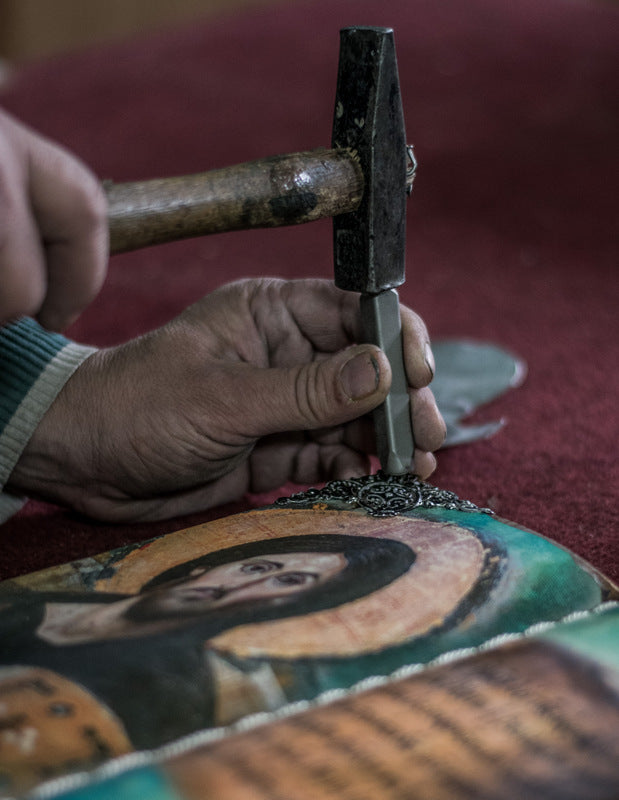Byzantine Silver Orthodox icon of Saint George
This exquisite Byzantine serigraphy icon, crafted from pure Silver 925* and enhanced with PVD for lasting durability, depicting Saint George while adhering to the esteemed Athonian technique. Its intricate artistry not only conveys deep religious significance but also enhances the aesthetic appeal of any setting.
Saint George, the great martyr and trophy bearer, was born in Cappadocia in 275 AD to Christian parents. After his father was martyred for his faith, his mother, (Saint Polychronia) and ten-year-old George settled in her hometown in Palestine. At the age of 18, George joined the Roman army and quickly rose through the ranks, eventually acquiring the title of Earl.
During Emperor Diocletian's campaign against Christians, he summoned all officials to wage a brutal war against them. George, present among them, openly confessed to the emperor that he was a Christian. Diocletian, outraged, imprisoned George and subjected him to a series of tortures. The executioners tied him to a large wheel, and as it turned, sharp irons began to slice his body. In response, a heavenly voice reassured him, “Do not be afraid, George, for I am with you,” and an angel appeared to heal his wounds.
Subsequently, they threw George into a pit filled with lime and water in an attempt to dissolve his bones, but he remained unharmed. Diocletian then ordered him to wear burning shoes fitted with iron nails, forcing him to walk. St. George prayed and walked without suffering any harm. Eventually, they wounded him all over his body, yet he continued to shine like an angel. After being imprisoned again, Saint George dreamed that Christ announced he would receive the crown of martyrdom. The next morning, soldiers led George before Diocletian, where he once again refused to sacrifice to idols, leading Diocletian to order his decapitation.
George ultimately suffered martyrdom by beheading on Friday, April 23, 303 AD. According to the calculations of the Christian historian and apologist Saint Eusebius, this day corresponded to the Friday of Life-Giving Spring of Easter. The Christians buried his relics alongside those of his mother, who was also martyred on the same or the following day. According to Christian tradition, George's loyal servant, Pasikrates, fulfilled his wish by retrieving both their relics and transporting them to Lydda in Palestine. Emperor Constantine later built a church over the grave.
Saint George is recognized as the patron saint of the Infantry and the Army, as well as the patron saint of England. He is also venerated as the patron saint of the Crusaders and Scouts. Known as a military saint and liberator, he is associated with many remarkable stories and traditions, the most famous being the tale of him slaying a dragon and rescuing a princess. This dragon guarded the waters of a spring near Silene in Libya, allowing them to flow only when it found a human to devour. The local residents determined the dragon’s victim by drawing lots, and despite entire armies fighting the creature without success, the lot fell to the princess, whom Saint George saved by defeating the dragon. The Church celebrates the memory of Saint George on April 23rd.
This icon is designed for versatile display; it can be hung on a wall or placed on a flat surface, making it an elegant addition to any home or sacred space. The harmonious blend of religious themes and artistic craftsmanship, along with its rich theological context, renders it a meaningful tribute to the Christian faith.
Available Colors:
Choose from five beautiful colors for the icon: Blue, Gray, Gold, Blue- Red, Silver-Gold.






